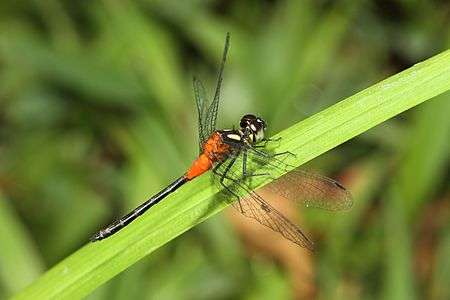Epithemis mariae
Epithemis mariae[2] is a species of dragonfly in the family Libellulidae known commonly as the rubytailed hawklet.[3][4] It is endemic to the Western Ghats, India. The species is found in small colonies closely associated with forested marshes.[3][4][5][6]
| Epithemis mariae | |
|---|---|
 | |
| male | |
.jpg) | |
| female | |
| Scientific classification | |
| Kingdom: | |
| Phylum: | |
| Class: | |
| Order: | |
| Family: | |
| Genus: | Epithemis |
| Species: | E. mariae |
| Binomial name | |
| Epithemis mariae (Laidlaw, 1915) | |
| Synonyms | |
|
Amphithemis mariae Laidlaw, 1915 | |
Description and habitat
It is a small dragonfly having black pro-thorax and thorax with a broad greenish yellow humeral stripe on either side. Segments 1-3 of the abdomen are brick-red, the remaining segments are black; segments 4-7 have a basal yellow ring. Female is golden yellow with black markings.[7]
This species occurs in small colonies in bogs at the foot of the hills where it breeds.[7][8][9]
gollark: * OOPy vs FPy* Verbose vs not verbose* Brackety vs Indentationy/whitespacey
gollark: You can compare C# with F# fine.
gollark: They're both .NET languages supporting similar stuff.
gollark: You can!
gollark: C# is the worse F#.
See also
- List of odonates of India
- List of odonata of Kerala
References
| Wikimedia Commons has media related to Epithemis mariae. |
| Wikispecies has information related to Epithemis mariae |
- Kakkasery, F. (2011). "Epithemis mariae". IUCN Red List of Threatened Species. 2011: e.T59864A83847795. doi:10.2305/IUCN.UK.2011-1.RLTS.T175179A7117994.en.{{cite iucn}}: error: |doi= / |page= mismatch (help)
- Martin Schorr; Dennis Paulson. "World Odonata List". University of Puget Sound. Retrieved 12 October 2018.
- "Epithemis mariae Laidlaw, 1915". India Biodiversity Portal. Retrieved 13 February 2017.
- "Epithemis mariae Laidlaw, 1915". Odonata of India, v. 1.00. Indian Foundation for Butterflies. Retrieved 13 February 2017.
- K. G. Emiliamma, C. Radhakrishnan. "Odonata (Insecta) of Parambikulam Wildlife Sanctury, Kerala, India" (PDF). Western ghats field Research Station, Zoological Survey of India,Calicut. Retrieved 13 February 2017.
- K.A., Subramanian; K.G., Emiliyamma; R., Babu; C., Radhakrishnan; S.S., Talmale (2018). Atlas of Odonata (Insecta) of the Western Ghats, India. Zoological Survey of India. pp. 324–325. ISBN 9788181714954.
- C FC Lt. Fraser (1936). The Fauna of British India, including Ceylon and Burma, Odonata Vol. III. Red Lion Court, Fleet Street, London: Taylor and Francis. pp. 258–259.
- C FC Lt. Fraser (1924). A Survey of the Odonate (Dragonfly) Fauna of Western India and Descriptions of Thirty New Species (PDF). p. 430.
- Laidlaw, F. F. (1915). "Notes on Oriental Dragon-Flies in the Indian Museum" (PDF). Rec. Indian Mus. 11: 337–339. Retrieved 10 October 2018.
This article is issued from Wikipedia. The text is licensed under Creative Commons - Attribution - Sharealike. Additional terms may apply for the media files.
